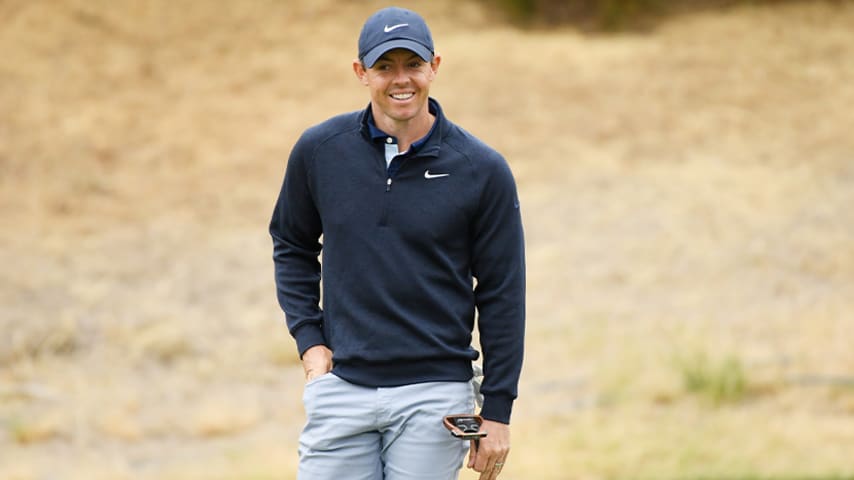Stories from 'the gauntlet of golf' known as Q-School
12 Min Read

GREER, SC - MAY 18: Max Homa crosses the bridge on the ninth hole during the final round of the BMW Charity Pro-Am Presented by SYNNEX Corporation held at the Thornblade Club on May 18, 2014 in Greer, South Carolina. (Photo by Michael Cohen/Getty Images)
Max Homa is one of the most popular figures in professional golf these days. He has no issue roasting someone’s swing on social media, is quick with a laugh and has won on the PGA TOUR.
But despite the fact he was a star in college and had all the hypotheticals working in his favor in terms of what was to come next on professional golf’s ladder, he still went through the Qualifying Tournament.
It was 2013. Homa participated in the first Q-School that took players to the Korn Ferry Tour, and not straight to the PGA TOUR. There were six rounds to be played at Final Stage, and Homa – along with PGA TOUR winners Tony Finau, Nick Taylor, Carlos Ortiz, Si Woo Kim, Ryan Armour, Daniel Berger and FedExCup winner Justin Thomas, to name a few – were all in the pressure cooker together that week.
“You know, it’s just not very fun,” said Homa with a laugh.
Homa finished T6 that week, earned Korn Ferry Tour status, and won in 2014 to earn a PGA TOUR card for the first time. Golf was easy then, he said, but it got harder. He had to move through Q-School again just a few years later, but found the TOUR winner’s circle in 2019.
Still, he looks back on that week at Final Stage, and the whole of the Qualifying Tournament system, as one of the biggest tests of his professional career. In 2013, he said he was playing some of the best golf of his career. He admits, with a laugh again but this time almost in spite of his attitude, that he had a false delusional mindset about his game.
It helped.
“I was more intimidated by the tournament than the people,” said Homa. “The class was good, but we didn’t know at the time just how good.”
For decades it was all about getting onto the PGA TOUR, but that ceased with the Q-School event in 2012. Since 2013, it’s been an opportunity for golfers – from college stars to well-established professionals – to get onto the Korn Ferry Tour, the final stop on the path to the PGA TOUR.
Some things have changed in terms of the week itself. But one thing hasn’t changed is how much of a grind the entire experience is.
A grind can take various shapes and forms. It’s “a difficult situation – oppressive and seemingly without end,” according to the Oxford Dictionary, which also calls it “the reduction of something to small particles or powder by crushing it.”
Regardless of how it is viewed – it’s just really, really hard. One can get crushed.
Homa said that on the final night of 2013 Q-School, a few guys went out for beers. There was some celebration. There had to be. No one went home, since there was an eight-hour orientation the following day (“A lot of people, including myself, were not in the best shape for it,” said Homa). He said, though, players just wanted to breath. They made sure to appreciate what they had gone through.
“It’s just like,” Homa said, “the gauntlet of golf.”
THE MENTAL GRIND
Steve LeBrun has been to Q-School 11 times.
He says it casually, like it was just part of his life’s journey. He has three kids and a wife now. He’s not out of the woods yet, even at 42, in terms of what could happen in golf. He hasn’t won on the Korn Ferry Tour or PGA TOUR in his career. A return trip to Q-School could be one day in the realm.
But in 2012, there was something different about the week. His wife, Jen, gave birth to their second daughter the night before Second Stage of Q-School. He brought a book with him to Final Stage and sat alone at dinner and lunch reading it. He said, reflecting back, he actually enjoyed the week of nights in a hotel – the sleeps were quiet.
Q-School fosters a concern, LeBrun said, that early-calling a playing partner’s shot – paying a compliment before the ball settles in less optimal position – can result in bad juju.
“Ninety percent of the guys are walking on eggshells,” said LeBrun. He had played in the U.S. Open, his first major, earlier in the year. It wasn’t close to the pressure he felt at Q-School.
“The U.S. Open was nerve-wracking because of the number of people lining the fairways, how hard the course was, and because you didn’t want to look foolish,” said LeBrun. “But definitely, those Q-School days are some of the most pressure ever.”
He led Final Stage after the first day that year. But he said he might have been even more nervous leading the tournament than he would have been chasing a number.
“I don’t think I dropped outside the top seven in any round, but that’s just three shots from being outside the number. You’re on edge every shot,” said LeBrun. “Even though I was leading … I just remember it being like all the other ones.”
It’s not easy, mentally, to move one’s way through a multi-level test like Q-School. Much has been written on Q-School and who comes from where and how and what. But every year, there’s a new story or a new crop of guys who make it, or break it, during that Final Stage effort.
“I remember I was broke before I signed up for that Q-School,” said Chris Baker, who advanced in 2013. The Iowa State alum won the Greater Cedar Rapids Open the year prior just to put enough cash in his pocket to pay the entry fee.
“Everyone is sweating,” said Homa. “Golf, in general, there’s comaraderie. I … was wishing I could talk to people a little bit. But I feel like everyone was out of their comfort level a little bit.”
That discomfort really starts at Second Stage, according to players who have been through it before.
Advancing through Second Stage and into Final Stage, even prior to 2013, earns something. Some status. Some place to play. Second Stage still gives guys the heebie-jeebies talking about it.
“There was more pressure at Second Stage for me,” said Roger Sloan, who finished T15 at Final Stage in 2013 and would go on to win on the Korn Ferry Tour the next year. “If you don’t get through, then it’s back on the mini-tours and it’s another year before you can have a kick at the can.”
LeBrun agrees.
“Final Stage is Final Stage, but for me, Second Stage was everything,” said LeBrun. “Q-School by name is more pressure packed than any other tournament, but for me I don’t think Final Stage is as pressure-packed as Second Stage.”
It’s not much for single guys, LeBrun said – save the emotional toll it may take chasing Monday qualifiers, cobbling together a mini-tour schedule, and laying in bed wondering what-might-have-been. But with kids and mouths to feed and a mortgage to pay, it can sting at the deepest level.
“Because if you don’t get through Second Stage,” he said, “you have no job.”
THE PHYSICAL GRIND
Just when one feels a sense of sweet relief after Second Stage (“I felt like there was an ‘ease’ when you got to Final Stage. I got a job; I had something,” said LeBrun) and, perhaps, a reset of emotions and what it means to be playing golf for a living, there’s an important switch in mindset upon arrival at Final Stage.
For years the grand finale was played over six rounds.
Homa got off to a bad start during the first round in 2013, he said. Had a little trouble getting into a groove. His caddied stopped him and said something that he still remembers vividly now, almost seven years later.
“He said, ‘Max, we literally have 100 holes left,’” said Homa. “It was funny, but it was accurate.
“Six rounds was just very freaking long.”
Sloan knew that slow-and-steady was going to eventually win the race – a race that’s dubbed golf’s longest.
“You shoot a couple under and shoot a couple under and you keep trying to grind away. Hopefully after six rounds you have a good round in there, and we did,” said Sloan, who finally got that good round he was looking for in the Sunday finale: a 63 to push him past the magic number.
Homa had a unique way of describing Final Stage, which was echoed by others.
“It felt like it was a really messed-up Groundhog Day,” said Homa of having to do the same thing over and over. “You don’t really want to be there, but you have to be in that mindset to succeed. That was the hard part.
“It’s pretty physical out there just because of the amount of golf we played. We played eight rounds – two practice rounds and six tournament rounds and it was swinging and hitting balls over and over again. It was exhausting. And it’s not just one tournament, you’re trying to set up your livelihood.”
Brad Fritsch has a unique relationship with Q-School, having done it starting in 2001. He knows what that week is like to set up a livelihood, like what Homa said about the experience. In 2015 he won the whole thing – he was medalist at Final Stage after playing what he called the best golf of his life.
“But it’s repetition over and over again,” said Fritsch. “You’re getting up around the same time every morning. The whole week … it’s just so long. A minimum of three days before, six days of competition, and nine or 10 days all in a row in the same area. It’s a lot.”
In 2006, he was walking down the fairway late in the final round with playing partner Ryan Howison. This was five years after he first tried at Q-School. They looked at each other, sitting at 10-under, and said, ‘We’re good, right?’ The number starting the day was 6-under, so they figured the final-round result would be 8-under. At Q-School, players used to be able count on, as Fritsch called it, the ‘choke factor’ by a few guys, and they both didn’t think it was going to move too much from 6-under par.
It turned out Fritsch and Howison both got through … right on the number. It was 10-under.
“It was a huge feeling of relief, finally getting some status, some membership,” said Fritsch. “But most of the day you just feel sick to your stomach.”
THE EMOTIONAL GRIND
Edward Loar can only laugh about it now. He said it himself: he choked his guts out.
In 2012, Loar was on the cusp of earning PGA TOUR status through the very last Q-School that sent players directly to the TOUR. He was in third place and just two shots off the lead heading into the final round. He was 3-over by the time he got to No. 17, but still inside the cut line. He hit his tee shot off the rocks surrounding the island green and made a double bogey. He hit the rocks again on No. 18 and made bogey. That was it.
“Every year unfortunately it happens to someone,” said Loar, who now works at a commercial insurance agency in Texas. “I was the last guy it happened to before they changed the format. I guess I’ll live in infamy for the rest of my life.
“It’s an incredibly cruel game and I remember how well I played that week and then the last day … It wasn’t anything in particular that happened. It wasn’t anything crazy, but the pressure got to me. Of course it got to me.”
Loar was a star collegian, rooming with Charles Howell III at Oklahoma State, but never quite found his footing on the PGA TOUR. He had some big success in Asia, but he just couldn’t quite convert it all on the biggest stage in the sport. He referred to Q-School as ‘Groundhog Day,’ just like Homa, and he said he knew how much that week could change one’s life.
After what happened to him in 2012, he said he got about 100 text messages. He had little kids at home, and he said he started crying while talking to his wife. The immediacy of the moment was really tough, he said. The whole week was emotional and mental, and perhaps Loar never quite recovered from what happened.
“You’re talking about 25 cards that have the potential to change your livelihood,” said Loar. “You obviously worked all year to get there, or, some guys had fallen down so it was a last-ditch effort to save your year. At that point it was a mental grind, but there are ups and downs with six rounds of golf … and it was ramped up tenfold.”
But golf is only one part of one’s life. Loar is very content with being a dad and playing golf casually these days. He hasn’t missed things in professional golf one bit, he said.
Others, like LeBrun and Fritsch, have Q-School in their mind most of the time through the year. It’s a fine line between keeping a job and losing it. In golf, there are no handouts.
Homa, Nick Taylor, Tony Finau, and of course, past FedExCup champion Justin Thomas, have gone from the Q-School grind into the PGA TOUR winner’s circle. Twice, in the case of Taylor, and multiple times, including a major, for Thomas.
Homa jokes now that Thomas was the odd man out amongst the group of players at Final Stage in 2013 who had some success at the college level, finishing T32. Still, Thomas would go on to win on the Korn Ferry Tour in 2014, like Homa, and notch seven top-10s. The rest is history for him.
But back then, nothing was guaranteed for those guys.
Emotionally charged, physically taxing, and mentally draining, there’s nothing like Q-School in the game.
“I remember when I got my PGA TOUR card via the Korn Ferry Tour and I didn’t have to go to Q-School that year,” said Baker. “It was the greatest feeling ever.”








